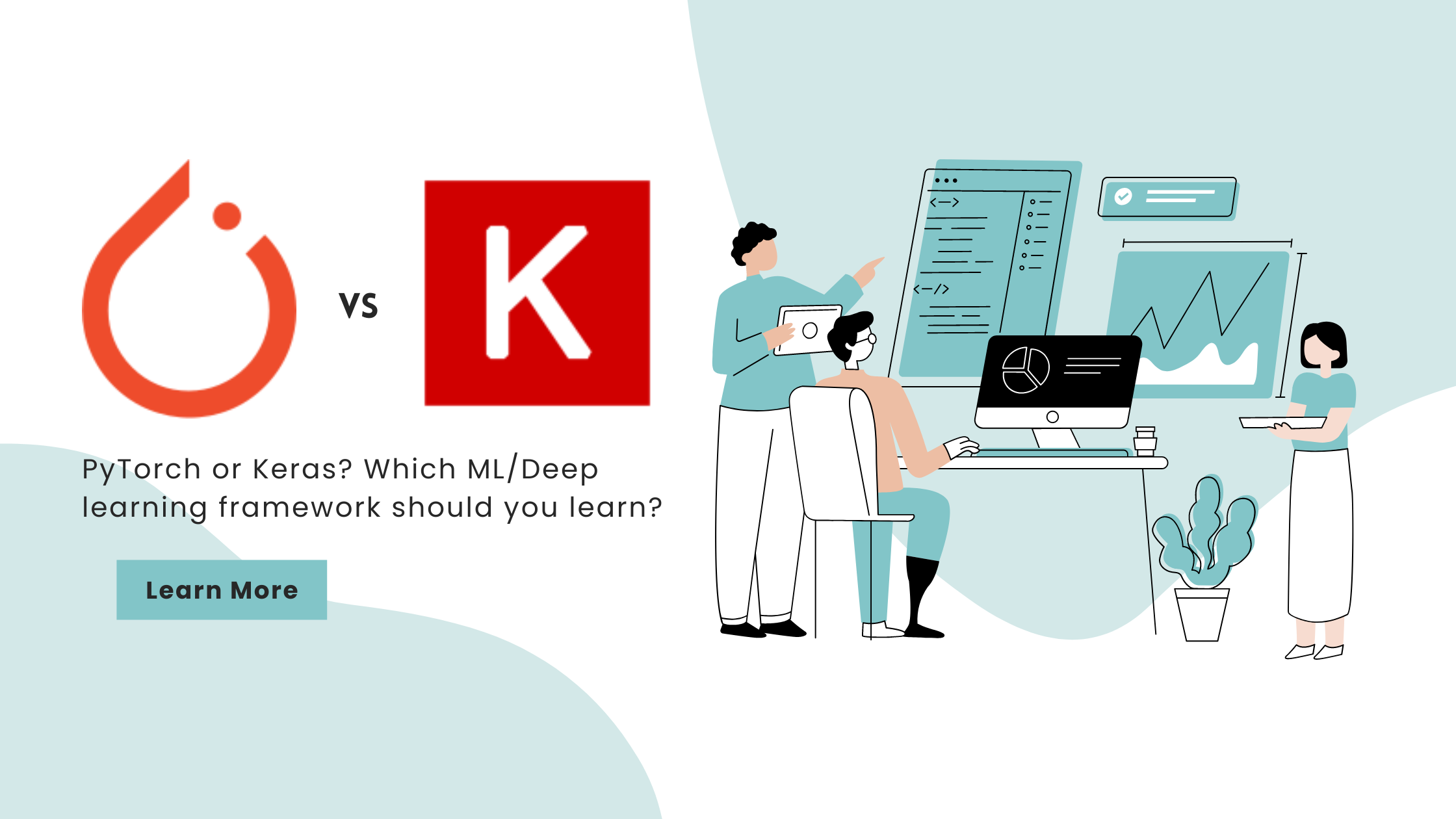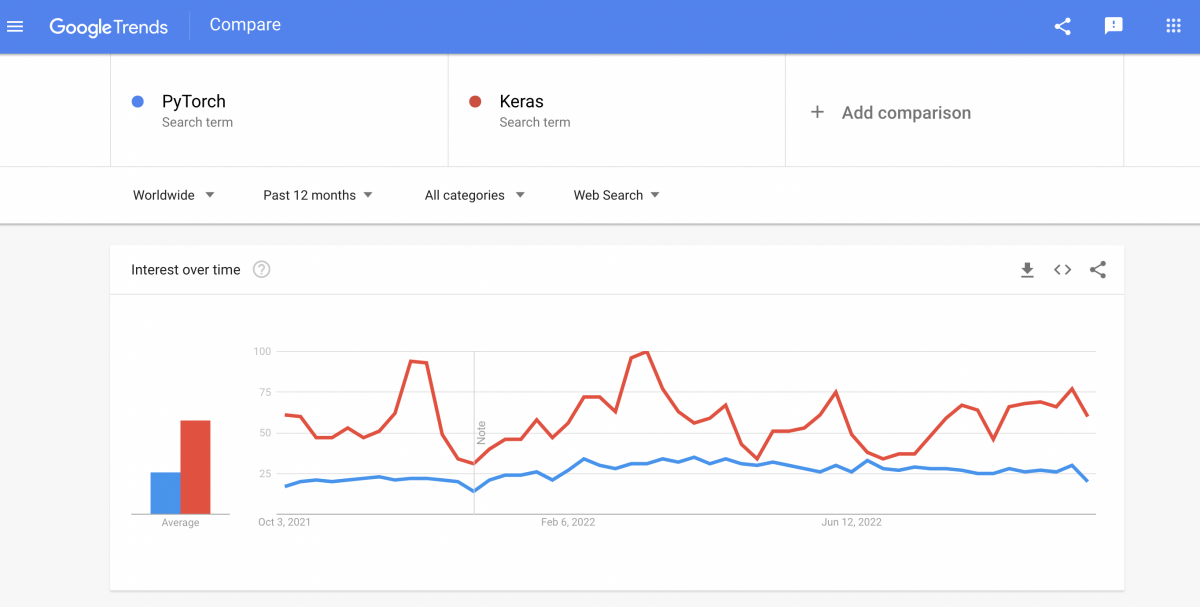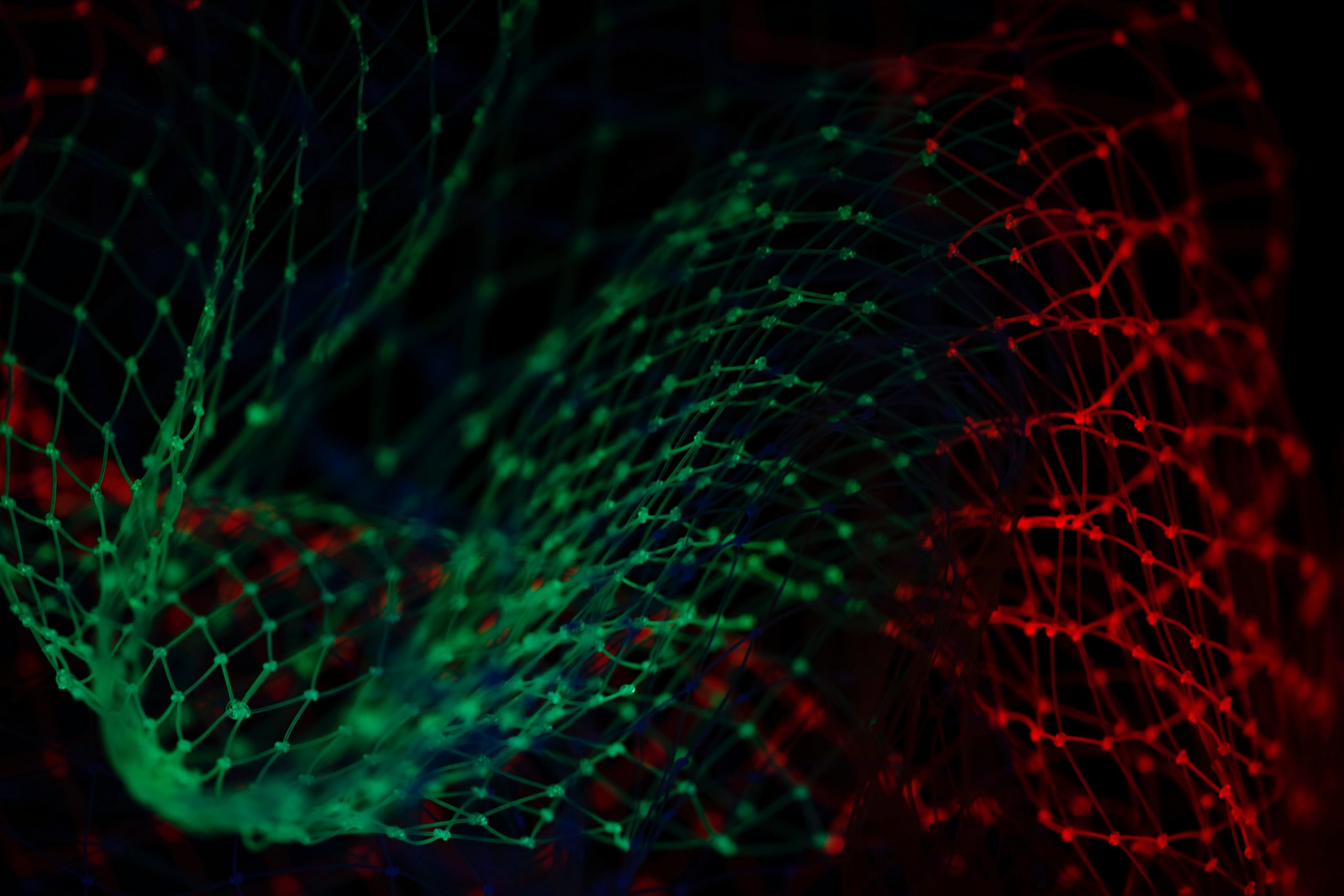
PyTorch vs Keras: Which ML framework is the clear winner for your first Deep Learning Model?
Mar 20, 2025 4 Min Read 5351 Views
(Last Updated)
Deep Learning is the hottest buzzword in tech train, for now, and it looks like every tech giant is boarding. Deep Learning imitates the human brain’s neural pathway to process data, primarily used for decision-making, recognizing speech, detecting objects, and translating.
It comes without human supervision or any human intervention pulling every assessment from unlabeled and unstructured data. In case, you wanna pursue these futuristic skills, start applying them to your business or gain marketable skills, the first essential step is to get familiar with top deep learning frameworks.
There are many with various use cases, but for beginners, we strongly recommend you pick either PyTorch or Kears. These are the most widely accepted deep learning tools, which are enjoyable to learn and experiment with.
In this article, we’ll outline all the differences between PyTorch and Keras and pit them against each other & in the end a verdict. So without wasting any time, let’s begin with PyTorch vs Keras.
Table of contents
- Let's begin with Introductions
- Keras
- PyTorch
- PyTorch vs Keras: Head-to-Head
- Debugging and Inspection
- Performance
- PyTorch Vs Keras: Cross-Platform Portability
- PyTorch Vs Keras: Popularity & access to learning resources
- A Quick Comparison Chart for PyTorch vs Keras
- Ease of use & Pythonic
- Data Sets
- PyTorch Vs Keras: The Conclusion
Let’s begin with Introductions
PyTorch and Keras, are both open-source frameworks for deep learning neural networks, gaining much popularity among data scientists.
Before we move into the next section, If you’re interested in Data Science, ensure you have a good grip on data science essentials like Python, MongoDB, Pandas, NumPy, Tableau & PowerBI Data Methods. If you are looking for a detailed course on Data Science, you can join GUVI’s Data Science Course with Placement Assistance. You’ll also learn about the trending tools and technologies and work on some real-time projects.
Keras

Keras is a high-level API designed for human beings and not machines. It follows the best practice in order to reduce cognitive load. Technically, it’s a neural network platform that runs on top of libraries such as CNTK, TensorFlow 2.0, MXNet & more. It is founded by François Chollet, a researcher and french engineer in AI.
Since its initial release in 2015, Keras has grown more considerable and gained favor from the AI community for its ease of use and syntactic simplicity.
It also facilitates fast development, and in mid-2017 its development became one source with Google’s Tensorflow when google announced the integration of Kears as a High-level API for TensorFlow 2.0.
So to install and use Keras, you just need to install the newest Tensorflow 2.0. However, the Keras library can still operate separately and independently with other tools.
PyTorch

PyTorch on the other hand is a low-level API written in Python Programming and developed by FAIR ( Facebook AI research ). The primary objective of this framework is to accelerate the path from research prototyping to production deployment.
At its inception, PyTorch gained popularity for academic and research purposes because of its capability for debugging on the fly. But it has gained immense interest in the previous year, becoming preferred for academic research and even development in mobile application development. Its focuses on the direct work of array expression.
PyTorch is still in its development stage and the developers involved with the project are Adam Paszke, Sam Gross, Soumith Chintala, and Gregory Chanan. To install PyTorch, we advise you to use Anaconda and Conda installers.
Further, we’re going to compare PyTorch and Keras with different metrics such as pythonic, debugging and inspection, training, dataset model, performance, production, and popularity. So let’s dive in for a head-to-head comparison of PyTorch vs Keras.
GUVI’s IIT-M CCE Machine Learning Course features one of its kind, holistic curriculum to help developers, data scientists & engineers to gain knowledge of machine learning techniques such as data transformation & algorithms that can find patterns in data and apply ML algorithms to tasks of their own design.
PyTorch vs Keras: Head-to-Head
Debugging and Inspection
Debugging in PyTorch is a lot easier as it has a dynamic computational graph on the way how it’s developed. Whereas in Keras, it’s hard to find the flaws within your code.
However, if compared to TensorFlows, Keras provides debugging utilities. But Keras is a high-level language and requires little to no debugging. In PyTorch, you can adapt a pythonic way to see what actually is happening in your model, and debug the complete model in a fast and easy manner.
So PyTorch is the clear winner when it comes to debugging and inspection. On Top of that, you can also use tools and libraries to get an enhanced and sophisticated inside view of the network.
Performance
In most instances of data science projects, the speed benchmark shouldn’t be the first criterion to decide the performance metrics: especially when it’s your first deep learning model.
PyTorch is as faster as TensorFlow, however, Keras is consistently slower. While you are building your first deep learning model, the bottlenecks will be likely caused by unoptimized networks, failed experiments, and data loading.
On the other hand, Keras offers ease of experimentation being a high-level API, whereas gains in computational efficiency of higher-performing frameworks such as PyTorch will in most cases be outweighed by the fast development environment.
So as far as training speed is concerned, PyTorch outperforms Keras.
PyTorch Vs Keras: Cross-Platform Portability
Running on TensorFlow, Keras enjoys a wider selection of solid options for cross-platform portability. With the help of TensorFlow Mobile and Lite, you can deploy the model into mobile platforms using Keras.
On the other hand, PyTorch serves models in Pickles that are mostly Python-based and thus aren’t that portable. Keras can also be used with R programming language, giving itself an upper hand in platform portability.
PyTorch Vs Keras: Popularity & access to learning resources
First thing first, a framework’s popularity is not a proxy for its usability, and there are many ways to target this. First, there is Google Trends, which framework is being searched more on search engines. And then there are research citations, tutorials, ease of learning resources, discussion forums, groups, and community support.

As you see in Google Trends, Keras wins over Pytorch in terms of interest over time and overall searches. TensorFlow is in the same leagues as PyTorch but Keras takes the lead. Read this blog to learn a detailed comparison of PyTorch Vs TensorFlow.
However, since 2018, both Keras and PyTorch are gaining popularity, becoming the fastest-growing data science tools. (Citing KDnuggets’ survey). Both languages have a considerable amount of mentions in GitHub and arXiv papers, although Keras is slightly above its peer.
While both frameworks have satisfactory documentation, PyTorch enjoys stronger community support. Python discussion board has the strongest support and will provide you with quick resolutions if you’re stuck.
Meanwhile, Keras’s readability of code & unparalleled ease of experimentation makes it a primary choice for deep learning enthusiasts, tutors, and hardcore Kaggle winners.
Anecdotally, we found well-annotated beginner-level deep learning courses on a given network architecture easier to come across for Keras than for PyTorch, making the former somewhat more accessible for beginners.
So it looks like we have a draw here. PyTorch offers great community support and active development, and Keras offers great access tutorials and code reusability.
A Quick Comparison Chart for PyTorch vs Keras
| Element | KERAS | PyTorch |
|---|---|---|
| API | High-Level | Low-Level |
| CODING | Python | Python |
| Architecture | Simple | Complex |
| Data Sets | Small | Large |
| Speed | Slow | Fast |
| Debugging | Challenging | Fast & Easy |
| Backend Implementation | TensorFlow, Theano, and Microsoft CNTK | No |
| Community Support | Simple | Complex & Wide |
| Interface | Python | Python, C/C++, Julia |
| Computational Graphic | Static | Dynamic |
| Ease of Use | Good For Beginners | For Researchers, Mathematicians |
| Visualization | Depends on Backend | Limited |
| License | MIT | BSD |
Ease of use & Pythonic
Keras and PyTorch differ in terms of their abstraction, and the level on which they operate on. Keras is a High-level framework that is wrapped around various deep learning layers, and operations into neat, lego-sized building blocks. Hence, the big deep learning complications are abstracted.
PyTorch offers a comparatively lower-level environment for experimentation, giving the user more freedom to write custom layers and look under the hood of numerical optimization tasks.
Thus the development of a complex architecture is possible when a developer can take complete leverage of Python and access all the functions. This naturally comes at the price of verbosity. It’s difficult and lengthy to define a simple convolution network in PyTorch when compared to Keras. As for the model training itself – it requires around 20 lines of code in PyTorch, compared to a single line in Keras.
So primarily it depends on whether your application will require flexibility beyond what pure Keras has to offer. If you are just beginning your Deep Learning Journey, Keras might be the framework to go for your first ML model.
Keras is a simpler API with concise coding whereas PyTorch is more flexible, and pythonic, and encourages a deeper understanding of Machine and Deep Learning objects.
Data Sets
As mentioned in the above paragraph, PyTorch is very flexible and rich for datasets. It features a Torchvision for computer vision use cases and at the same time Torchtext for NLP use cases.
So any developer can easily build their dataset class by just inheriting the default class & customizing it to be more accessible in terms of training and evaluation.
On contrary, Keras does not provide you with a lot of the dataset. Only a small portion of famous datasets like MNIST is supported by Keras. So the clear winner is PyTorch for dataset readiness and flexibility.
PyTorch Vs Keras: The Conclusion
PyTorch and Keras: Both are excellent choices for your first deep-learning project. If you are a researcher, mathematician, or otherwise curious to learn the nitty-gritty details of deep learning models and what’s going on between layers, consider picking PyTorch over Keras. It really shines, where more advanced customization (and debugging thereof) is required.
Keras is, without a doubt, the easier option if you are looking for a “plug and play” framework for its code reusability, fast builds, training, and evaluation. It can also save you a large chunk of time on intricate mathematical details.
If we take into account the above-mentioned matrics: PyTorch is the clear winner.
In Addition, we encourage you to try out simple deep-learning methods and recipes in both PyTorch and Keras to pick your favorite. Don’t forget to tell us in the comments section below about your experience.
Kickstart your Data Science journey by enrolling in GUVI’s Data Science Course where you will master technologies like MongoDB, Tableau, PowerBI, Pandas, etc., and build interesting real-life projects.






















![10 Unique Keras Project Ideas [With Source Code] 6 Keras Project Ideas](https://www.guvi.in/blog/wp-content/uploads/2024/10/Feature-Image.png)

![What is Object Detection? A Beginner’s Guide [2025] 8 object detection](https://www.guvi.in/blog/wp-content/uploads/2025/06/object-detection-2.webp)
![What is the Minerva Deep Learning Model? An Exclusive Beginner’s Guide [2025] 9 minerva](https://www.guvi.in/blog/wp-content/uploads/2025/07/minerva-1.webp)






Did you enjoy this article?